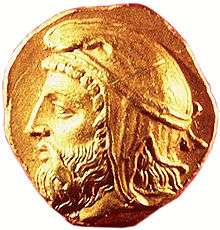Orontes I
| Orontes I | |||||
|---|---|---|---|---|---|
 Gold coin held at the Bibliotheque Nationale, Paris, dated to 362 BC. It therefore represents Orontes I. | |||||
| Satrap of Sophene and Matiene | |||||
| Reign | 401 BC – 344 BC | ||||
| Coronation | 401 BC | ||||
| Predecessor | Artasyrus | ||||
| Successor | Darius III Codomannus | ||||
| Died |
344 BC Ionia | ||||
| Spouse | Rodogoune | ||||
| Issue | Orontes II | ||||
| |||||
| House | Armavir | ||||
| Dynasty | Orontid Dynasty | ||||
| Father | Artasyrus | ||||
| Mother | Asatera | ||||
Orontes I or Yervand I (classical Armenian: Երուանդ Ա, Yervand I) was an Armenian king of the Orontid Dynasty who reigned between 401 BC – 344 BC. The Persian version of the name is Auruand which meant "Great Warrior" in the Avestan language. It is likely this was a special title given by the Persian king, though this seems to have become a hereditary title in that family.
Biography
According to the Greek sources (Herodotus, Strabo), Orontes was made Satrap of Sophene and Matiene (Mitanni).[1]
He was given these Satrapies after the Battle of Cunaxa in 401 BC for supporting the Persian king Artaxerxes II against Cyrus the Younger. It is likely he ruled from Armavir as the previous Satrap of Armenia, Hydarnes, had ruled from there. He married Rodogoune, the daughter of king Artaxerxes II by one of his concubines. He next appears in 381 BC as the army commander during the campaign to recapture Cyprus from its rebel leader, King Evagoras, whilst the navy was under the command of Tiribazus. They managed to lay siege to the city of Salamis; however, Orontes then impeached Tiribazus before king Artaxerxes II. Before three Persian noble judges, Orontes was found guilty .
In 362 BC a great rebellion occurred in Anatolia, led by Datames, Satrap of Cappadocia (Revolt of the Satraps). Some sources say that it was Orontes who was chosen by the rebels as their leader. However, Orontes stayed loyal to king Artaxerxes II and aided in the collapse of the rebellion. Apparently, he wanted to rule Anatolia and Armenia alone. He captured the city of Pergamon and sent bribes to Athens, where a decree seeking an alliance records his name. He was able to fund these activities as he is recorded as having a personal fortune of 3,000 talents of silver.
In 355 BC he rebelled against the new king of the Achaemenid Empire, Artaxerxes III. He still had possession of parts of western Anatolia. He fought a battle against the satrap of Daskyleion and minted his own coins in Ionia, such as the one displayed in the Bibliothèque Nationale in Paris. He handed back Pergamon to the king.
The kings of the Kingdom of Commagene claimed descent from Orontes I and also claimed Darius I of Persia as an ancestor, thanks to Orontes' marriage to Rodogoune, daughter of Artaxerxes II who was a direct descendent of king Darius I.[2][3]
Some ancient Greek sources called Orontes a "Bactrian", though it was because his father, Artasyrus (Artaxerxes), had been the Satrap of Bactria during the reign of King Artaxerxes II. Some sources suggest that Artasyrus was Artaxerxes II, who had seven known children and eleven children whose names are not known in Western historical records. During the Achaemenid Empire, Bactria was ruled by the heir to the throne.
Xenophon's Anabasis mentions that the region near the river Centrites was defended by the Satrap of Armenia for Artaxerxes II and named Orontes son of Artasyrus who had Armenian contingents. Xenophon mentioned that he had a son called Tigranes. His successor was Darius III and after Codomannus these Satrapies were ruled by Orontes II. Whether he was the same person as Tigranes but had adopted the name Orontes or that they were brothers is not known.
See also
References
- ↑ Petrie, Flinders. Mitannian (Armenian) origin
- ↑ Cook, J.M. (1993). The Persian Empire ([Repr.] ed.). New York: Barns & Noble Books. pp. 170, 173, 193, 212, 213, 216, 217, 221–223, 257, 263. ISBN 1-56619-115-7.
- ↑ The Armenian People from Ancient to Modern Times - 2 Vols., Richard G. Hovannisian, St. Martin's Press, New York, 1997